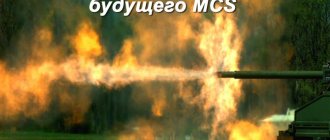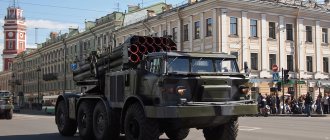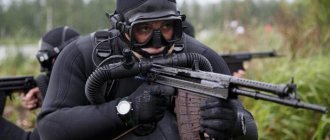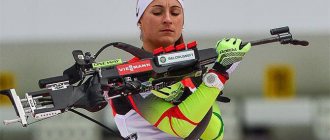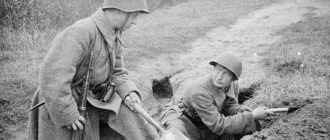Shovel-mortar?
Comrade Stalin, as you know, was a “great scientist” and studied not only fighting chickens, but also other ways to increase the effectiveness of the Red Army.
The idea of turning every soldier into an artilleryman, presented by specialists from NII-13 shortly after the start of the Great Patriotic War, seemed very interesting to Joseph Vissarionovich. The idea, by the way, was really good: to enable infantry (in the absence of artillery support) to work with fragmentation ammunition at ranges exceeding the throwing distance of a hand grenade.
Platoon mortar-shovel caliber 37 mm (VM-37)
As a result, an amazing hybrid was born, which is now called on the Internet “Dyakonov’s shovel-mortar.” This name immediately brings to mind the ancient joke about guinea pigs, which are not pigs at all and have nothing to do with the sea.
Battalion 82mm mortar
In 1936, a mortar launcher developed at the Leningrad SKB-4 under the leadership of D.I. Shavyrin was adopted by the Red Army. The 82-mm mortar had its baptism of fire in the battles at Khalkhin Gol, establishing itself as a reliable military weapon capable of hitting enemy targets at long distances. Subsequently, these artillery pieces were modernized.
Thus, new modifications of the 82-mm mortar appeared annually throughout all hostilities. These World War II mortars served faithfully for many years to come. Not a single military operation of the Soviet troops was complete without these weapons.
The successful use of mortars in World War II of this caliber led to their becoming the prototype for a lightweight version of the 1981 Model Tray mortar.
First of all, this is not Dyakonov
No, really. Mikhail Grigorievich Dyakonov, the creator of one of the first desktop grenade launchers, the RGD-33 hand grenade and the author of the three-volume “Theory of Artillery Fire,” simply could not put his hand to this ersatz.
Mikhail Grigorievich Dyakonov and scout N. Romanov, armed with a submachine gun designed by Shpagin PPSh-41 and four hand grenades designed by Dyakonov RGD-33
He knew very well about the low effectiveness of mines and small-caliber rifle grenades, and Dyakonov had nothing to do with NII-13, but was the head of the laboratory at TsKB-22. True, both of these institutions were located in Leningrad, and even competed with each other - perhaps this is where the confusion came from.
World War II rocket launchers
The Germans learned that the Red Army had weapons of unprecedented power at the very beginning of the war.
For the first time, a combat unit of rocket mortars under the command of Captain Flerov launched a massive attack on the Orsha junction station on July 14, 1941. According to the testimony of the surviving Nazis, a real firestorm hit the railway junction. The battery of rocket launchers struck not with simple shells, but with incendiary mixtures. The ground under the German soldiers and officers was burning under their feet.
The fame of the famous "Katyusha" instantly spread throughout the entire front. People in the rear knew about it too. The whole country made mines for mortars of the Second World War. The single motto for the entire population was: “Everything for the front, everything for victory.”
Secondly, this is not a mortar
That is, the manufacturers, of course, considered their creation a mortar, but the soldiers had a slightly different impression.
Firstly, due to the lack of even the most primitive sight, the situation with shooting accuracy was very bad. The manual for the VM-37 directly stated: “The aiming is corrected after observing the results of the first shot.” That is, we fire the first shot “somewhere in that direction,” look where it boomed sluggishly, and after that we twist the barrel-handle left and right, trying to hit the target.
According to the test results, it turned out that the shooting accuracy of the VM is seven times worse compared to a 50-mm mortar.
VM-37 with bipod insert (photo: Source)
It must be remembered that the “spitting” range of the VM-37 was very small - from 60 to 250 meters (in other words, in the enemy’s line of sight), so all manipulations had to be carried out under enemy fire.
An additional touch: the manual recommended not to tilt the barrel at an angle of less than 45 degrees, since the weight of the mine in such conditions might not be enough to puncture the primer.
Firing from a VM-37 shovel-mortar, drawing from a 1942 manual
Secondly, the design of the VM-37 was classified as unrepairable. The breech with a tightly secured firing pin was, in fact, inaccessible for maintenance. If the firing pin broke or bent during use, the weapon became an absolutely useless piece of iron and was scrapped.
Thirdly, the ammunition itself let us down. Just a cast iron glass equipped with feathers. Without notches and ready-made damaging elements. Its alignment was initially poor, and wartime factory tolerances are quite vague, so instead of flying forward with the fuse, the projectile could begin to tumble in the air.
Left: cross-section of a mine (drawing from a 1942 manual), right: pencil case and mine
And if the warhead doesn’t hit an obstacle, there won’t be an explosion... And even if it explodes, it’s of little use; The ammunition was five times less effective than a 50-mm company mortar.
Finally, fourthly: the mines themselves were quite heavy (about 500 grams), and the carryable ammunition was as much as 15 pieces.
To carry them, they used a special canvas bandoleer worn around the belt; each mine was enclosed in a special tin case, so that in the end the appearance of a fully equipped fighter was quite terrifying. But crawling on your bellies with such a bra didn’t work out very well...
Company mortar manufactured in 1938 and 1940. (caliber 50 mm)
Serial production of this artillery gun was started by the military industry of the Soviet Union in 1939. The developer is an experimental design bureau headed by B.I. Shavyrin. Schematically, the mortar is arranged in an imaginary triangle. The barrel-pipe and the carriage biped with a lifting mechanism were one side of this triangle, and the third imaginary side was the line between the support and the carriage.
Characteristics of a 50-mm caliber company mortar manufactured in 1938:
- Caliber - 50 mm.
- Weight – 17 kg.
- The mine's flight speed is 95 m/s.
- The maximum shot range is 800 m.
- Rate of fire – 32 rounds per minute.
- The weight of the projectile (mine) is 0.85 kg.
Subsequently, the design was improved at the V. N. Shamarin Design Bureau. And in 1940, a new version of the 50-mm mortar mount was released. As of June 22, 1941, 50-mm mortar guns became widespread in the Red Army, their number reached about 24 thousand units. These mortars of the Second World War were not particularly popular.
By the end of 1943, few military units used this type of weapon. The reason was the fact that the short firing range reached only 800 meters, which forced the mortar crews to get as close as possible to enemy positions. Due to this, combat units suffered multiple losses in manpower. This type of mortar launcher was especially popular among the partisans, who used it in their arsenal until the end of the war.
Thirdly, this is not a shovel
The outer diameter of the barrel of the VM-37 was more than 45 mm. This, to put it mildly, is a bit much for a shovel handle. The weight of one and a half kilograms is clearly excessive for an entrenching tool, the locking ring tends to become loose, and the tray also dangles. Grabbing a metal pipe in the cold is a dubious pleasure; even the canvas cover that slid along the surface of the barrel did not help. In general, if there was anything that could be dug with the VM-37, it would be a shallow hole for installing a base plate.
In addition, the production of the tray and stop did not use any kind of steel, but rather scarce steel, grade 35SGNA, used for the production of soldiers’ helmets. And even this material could not withstand the loads - when shooting in snow and soft ground, the tray sank and cracked.
It is not surprising that both the infantry and defense factories fought off the “non-shovelers/non-mortar gunners” in every possible way. This short-lived epic ended with a report from the head of the GAU (Main Artillery Directorate) Nikolai Yakovlev personally to Stalin. Joseph Vissarionovich read the report, realized the mistake, and the unlucky hybrid was removed from service.
He spent less than a year in the army.
History of military weapons
Back in 1904, during the defense of Port Arthur, Russian officers S. Vlasyev and L. Gotyabo created an unusual artillery weapon with a short tube-shaped barrel. The 47-mm naval gun was intended for mounted firing at enemy targets. The flight range of such an installation was small, only 400-500 meters.
Subsequently, World War I mortars were used as an effective means of trench warfare. However, over time, it was this improved invention that became a formidable weapon. World War II mortars caused a lot of trouble for German soldiers.
The mortar received its modern shape thanks to the first sample of the Stokes design. This is a pipe-barrel on a two-legged monitor support, resting on a flat metal plate, which dampens the recoil of a shot into the ground.
Several years before the war with Germany, the Soviet government began to persistently launch mass production of inexpensive and easy-to-maintain artillery weapons, believing that they would replace a whole range of artillery weapons. For this reason, the production of the Taubin automatic grenade launcher was suspended, which, during tactical tests in 1937, established itself as an excellent mounted combat weapon.
How to make a mine out of a mine
However, the story did not end there. After the remains of the VM-37 (not broken or lost) were finally removed from the troops, the Main Artillery Directorate faced another difficult task. Since the “non-dominant gun” was used very reluctantly, and ammunition for it was regularly produced by defense factories, a large number of those same 37-mm mines accumulated in warehouses, which - for a moment - were no longer suitable for anything at all. Specialists from the GAU strained their brains and overnight converted artillery ammunition into engineering ammunition.
Engineering mine POMZ-37 (photo: Source)
The fuse and expelling charge were removed from the mine, and a mastic plug with a hole (top) and a wooden peg (bottom) were installed instead. The most common domestic MUV fuse was inserted into the hole - the result was a kind of ersatz of the Soviet “anti-infantry” POMZ-2 called POMZ-37. True, nothing could be done with efficiency: in terms of combat characteristics, the new product was inferior even to an ordinary hand grenade. The explosive charge was a rather weak mixture of TNT and dinitronaphthalene, and the weight was only 20 grams.
Weapons of the Wehrmacht
German mines of the Second World War for mortars were made in various calibers, since the combat arsenal of Wehrmacht mortar installations had several modifications - 50-mm and 81-mm models of 1936 and 1932, respectively.
In some technical characteristics, the Wehrmacht mortars were superior to their Soviet counterparts. However, this did not help the German troops fulfill their main task - to win the war. It is noteworthy that captured German 81-caliber mortars of World War II were used by the Soviet army even after the victory. By the way, until 1955.
Video of the Lynx flamethrower
https://youtube.com/watch?v=YMwEc2gKqwg
The Lynx flamethrower became the first Soviet jet flamethrower, which began to replace the army LPO-50 jet flamethrower. The RPO "Lynx" was 10 times longer in range than its jet predecessor, the second advantage was that the fuel was ejected in a special container, which scattered when it hit the target, and in a conventional backpack flamethrower a lot of the mixture burned at a long distance until it reached the target. Another plus was that after the shot the shooter gave away his position much less and immediately threw off the shot container, becoming more mobile. For ease of shooting from a prone position, there was a bipod.
The main purpose of the RPO "Lynx" was to create fires, fight lightly armored vehicles and "smoke out" enemy personnel from cover.
When creating the RPO-Lynx, units from the RPG-16 anti-tank grenade launcher were taken. The flamethrower consisted of a reusable launcher with an aiming device and connected disposable containers with the fire mixture charges themselves, which were brought in blizzards of 2 pieces, the weight of one container was 11 kg. The launcher's lifespan is more than 100 shots. The fighter connected the container to the installation and could shoot accurately up to 850 meters, depending on the sight, the maximum shot range was 1000 meters. When fired from the barrel, the capsule with the charge was thrown out by a solid fuel engine, which burned in the barrel bore, simultaneously setting fire to the capsule with the mixture. Having reached the target and hit, the detonator exploded, which sprayed 4 liters of the fiery mixture by inertia 30-40 meters forward and 3-4 meters wide.
In the near future, the RPO "Lynx" began to be replaced by the RPO "Shmel", which was smaller, more compact and completely disposable. At the moment, the RPO-Lynx is available in military warehouses of the Russian Federation and the countries of the former USSR.
Modifications
“Lynx-Z” – incendiary ammunition, capsule with fire mixture MPS-1A. Causes fires and fire damage. According to the manufacturer, the impact of the ammunition is equivalent to the explosion of a 122 mm artillery shell. Fire mixture volume – 4 l (3 kg)
“Lynx-D” is a smoke munition that causes smoke in a volume or space.
Secret "Katyusha" - mortar of the Second World War
The main rule of guards mortars is the hidden occupation of combat positions. Move only in cloudy weather or at night so that the enemy cannot detect. In case of encirclement, everything was also thought out. Each vehicle was mined; at the slightest threat of capture, the installation had to be blown up. It was under such circumstances that Captain Flerov’s battery died along with its commander.
In 1942, the Germans still managed to capture a combat vehicle, but they never succeeded in creating a weapon like the Katyusha. The Soviet military industry constantly increased the production of rocket mortars.
Allied help
Since 1943, Soviet jet mortars of the Second World War were installed not only on domestic ZiS-6 trucks and STZ-5 tracked tractors, but also on Ford, Austin and Studebaker off-road vehicles received under Lend-Lease. New ammunition was also developed for Katyushas.
In particular, the rocket launchers received huge 300-mm projectiles. They were intended for well-fortified defensive structures. As a rule, Katyusha rockets hit squares. However, there have been cases when launchers had to be used for other purposes.



